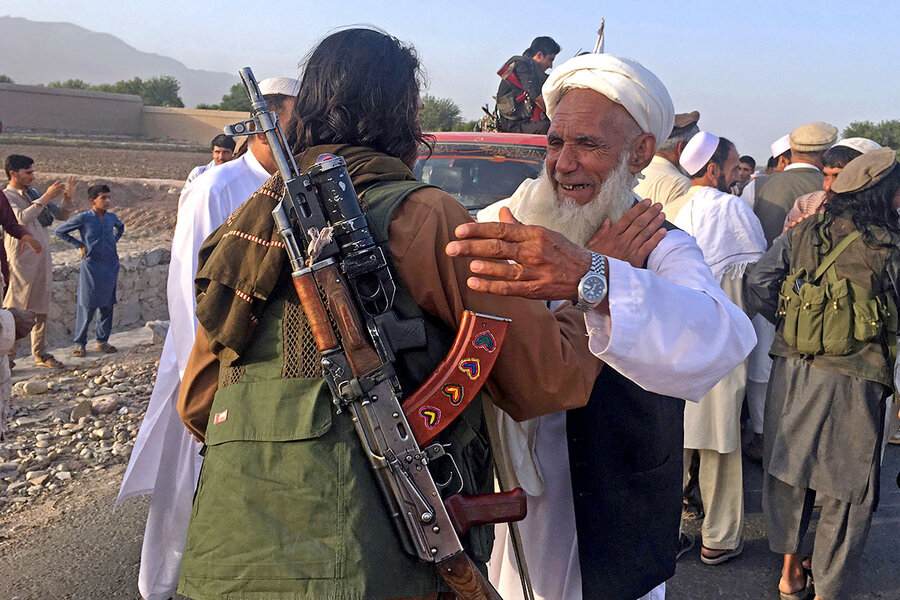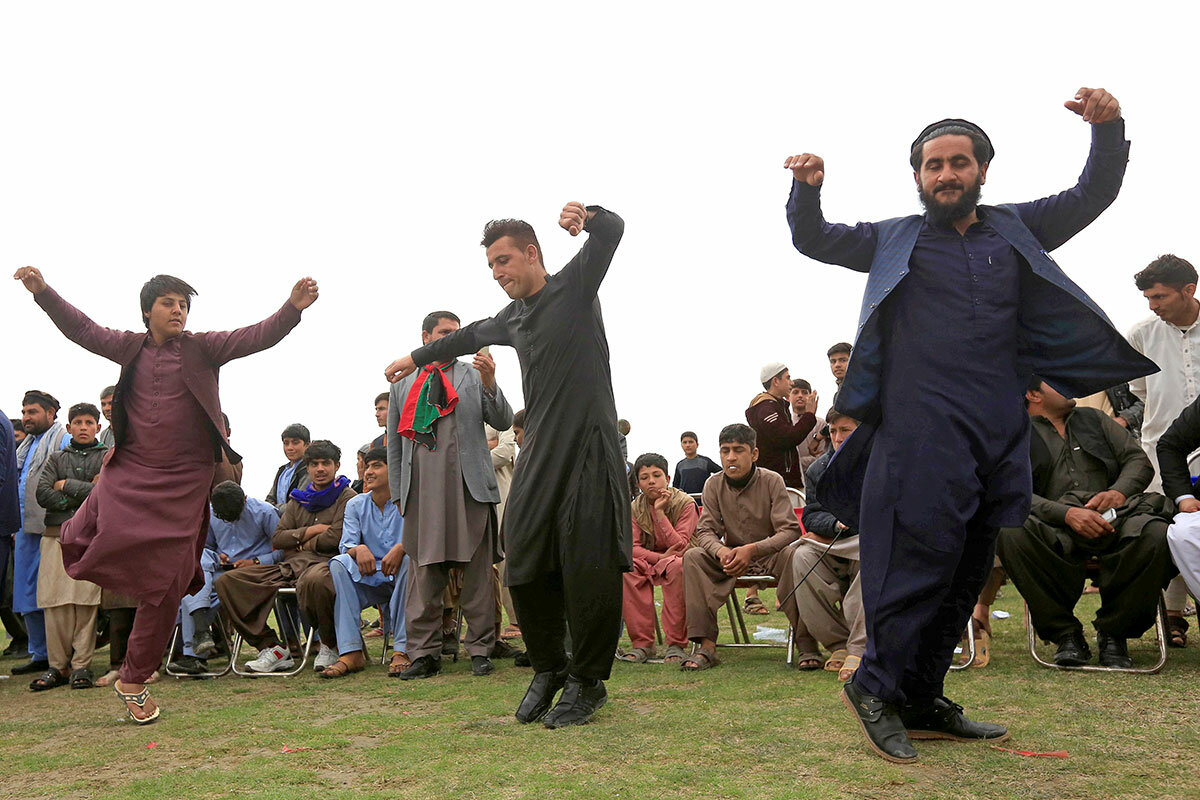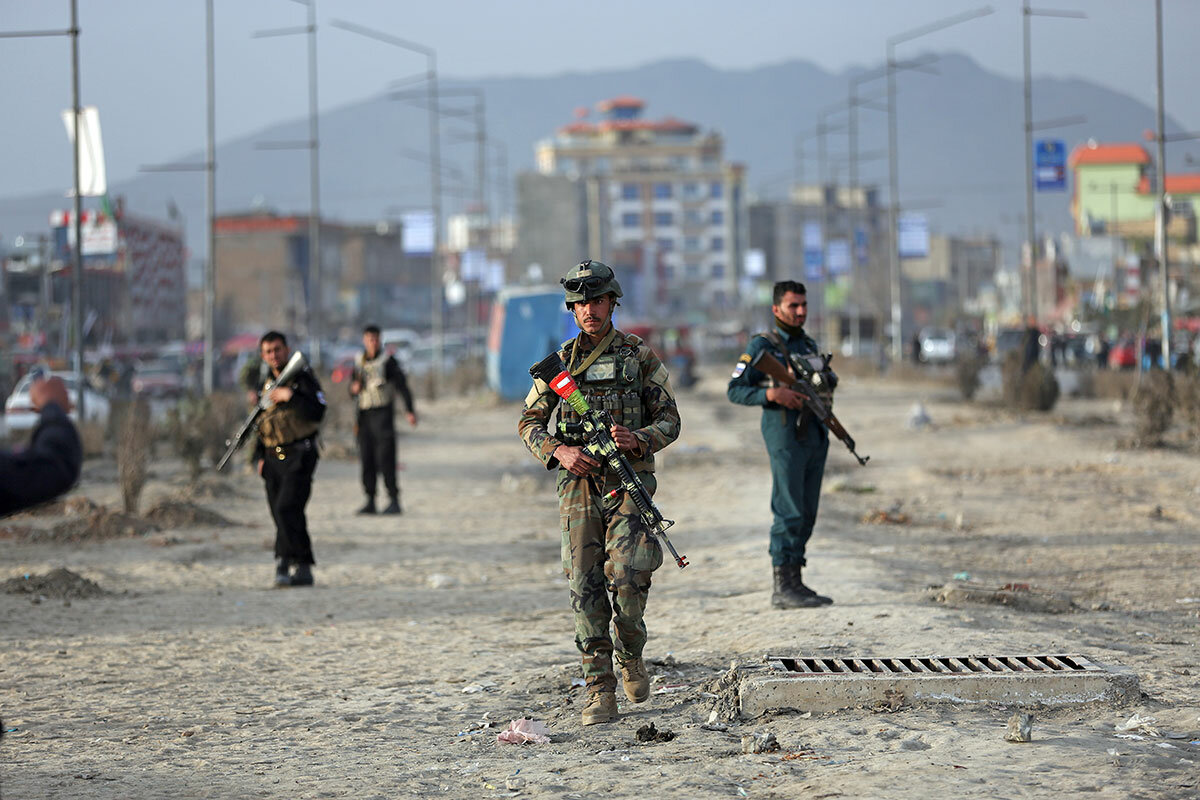Inside the Taliban: What these jihadis say about long-sought peace
Loading...
| MAYDAN SHAHR, Afghanistan
On a stony hillside in Taliban territory southwest of Kabul, a cluster of graves of Afghan security forces killed fighting the Taliban are marked with the red, green, and black flags of Afghanistan.
A stone’s throw away, a cluster of graves of Taliban fighters – entombed in the same frozen Afghan soil, and buffeted by the same winter wind as their dead enemies – are marked with the white flags of the jihadist insurgency.
As Afghanistan today nears the end of a seven-day reduction in violence to test the possibilities of peace – and with a U.S. troop withdrawal agreement due for signing Saturday to pave the way for ending America’s longest war – the proximity of these graves in Taliban-controlled Wardak Province symbolizes how minds have shifted toward peace among some insurgent fighters.
Why We Wrote This
If peace is to come to Afghanistan, shifting attitudes among the Taliban are key. Our reporter ventured into jihadi-held territory to speak in person with fighters. They are not of one mind on peace.
Taliban leaders have been negotiating with U.S. envoy Zalmay Khalilzad in Doha, Qatar, where the withdrawal deal is to be signed. But it is moments of illumination among local Taliban in places like this – along the Kabul-Kandahar road, with snow-covered mountains to the east, and citrus groves and farms to the west – that will determine whether peace can be forged.
Just down the road from the graves is where Taliban deputy district chief Suleiman Roostami says his mind changed, after last year attacking Afghan police posts at either end of a bridge.
“We killed them all,” says Mr. Roostami, a long-bearded, young-faced Taliban with an ocher skull cap and brown shawl draped over his leather jacket to ward off the chill. Nine policemen died, and three of the dozen or so attackers.
But the result? “Nothing, there was no result,” says Mr. Roostami – aside from changing his mind to see the futility of continuing the war along a road that for years has seen daily battles, is cratered from explosions, and is often besieged by Taliban snipers and kidnappers.
“Now we understand that this, our country, is being damaged,” says Mr. Roostami. “When I heard about these seven days [of reduced violence], I became very happy, because there is 40 years of war in this country.
“We are human and we want to enjoy a peaceful environment,” he says. “There is a good chance for all Afghans, because we are really tired – both sides – from the war.”
Shared skepticism
Among Afghans, however, there is no shortage of skepticism about the true intentions of the Taliban leadership – about accepting power sharing, and respecting nearly two decades of dramatic social change.
And even if the leaders are committed, can they control more radical commanders and fighters who are not?
The Taliban have steadily advanced against U.S.- and NATO-backed Afghan security forces, and now control or have influence in more than half the country – more than at any point since the U.S. military ousted the ultra-conservative Taliban in 2001.
Last year was the sixth in a row that saw more than 10,000 Afghan civilians killed and wounded, with the toll from Taliban attacks up 21% over 2018, according to United Nations figures. And with poverty as stultifying as ever, many jihadist fighters are recognizing the need for peace, says Mr. Roostami.
People living in the Taliban-held areas, he adds, “are still in poverty, still in conflict, and the government does not give services to them.”
Minds began changing in June 2018 during a three-day cease-fire, he says, when citizens and fighters on both sides crossed front lines and met “the other.” The current lull – officially a “reduction in violence” and not a cease-fire – only confirmed for many the possibility and desire for national reconciliation. Afghan officials said 21 security force members and 9 civilians were killed this week, less than half the number reported the week before.
A different Taliban?
There is no way to quantify the scale of change among the Taliban rank-and-file, since such expressions are anecdotal. The Taliban leadership in Doha insist they are today a kinder, gentler movement evolved from the iron-fisted enforcers that ran the “Islamic Emirate of Afghanistan” in the late 1990s.
“We were busy with fighting, we never thought that peace would come. Our one purpose was to become a martyr, to go to God’s side,” says Mr. Roostami, tracing his own rethinking. “Peace is also the way to God. So, we will enjoy the peace, but we will bring some Islamic changes to this new government.”
The Taliban leadership now says they recognize that women should work, and girls get an education, though under “Islamic” guidelines they have not defined. They also say they are ready for the next step – after a U.S. agreement to withdraw forces – to conduct an intra-Afghan dialogue with the Kabul government they long dismissed as a U.S. “puppet.”
Such talks are to begin March 10 and meant to eventually lead to a power-sharing deal and permanent cease-fire. But many voice doubts.
Amir Mohammad Malakzai, governor of Saydabad district further south in Wardak Province, plays audio messages issued several times a day from Taliban leaders in Pakistan to fighters, encouraging them to keep shooting Afghan policemen and soldiers – but refrain from killing Americans – despite the reduction in violence.
“We have some spy intelligence inside the Taliban, and hear what they say,” says Mr. Malakzai, himself a jihadist who battled the Soviets as a Mujahid in the 1980s. “They tell their people, ‘We beat the English, we beat the Russians, this is the third superpower we beat. After the deal is signed, we will create our own government, and kill and eradicate those who worked for the previous [U.S.-backed] governments.’”
Fighting “for our religion”
Another wild card are Taliban fighters who reject what they consider an “infidel” government in Kabul, led by President Ashraf Ghani.
One such fighter with piercing eyes gives his first name of Rahmatullah, and nom de guerre of Mullah Sarbakhod, which means one who rushes forward wildly, helter-skelter, without thinking.
“This peace and this cease-fire are useless, because our Prophet, our fathers, our grandfathers, our leaders were always in jihad, so that’s our only way, to continue jihad,” says the militant with mud on his black, ankle-high shoes – a signature accessory of many Taliban.
He says he doesn’t trust Taliban leaders, if they prefer money or promotions to the dangers of the frontline. And he says he kept up the pressure Wednesday – halfway through the reduction in violence and just a day before being interviewed – by helping blow up a nearby bridge.
“When they ordered me to destroy the bridge, I thought, ‘This is not jihad,’” says Rahmatullah, whose phone ringtone is a Taliban song. “Still we don’t know who we work for. They tell us, blow up this bridge ... kill this one, kill that one, attack this station, these police.
“But we don’t know who the order is from. Is it from Pakistan? From Iran? From India? From America?” the 50-year-old jihadist asks. “The only reason we are fighting is for our religion, to kill ourselves in this Islamic way, to become a martyr.”
Still, the war will continue if American troops remain, says Rahmatullah. He says he “really enjoyed” one operation in 2017, in which he helped place roadside bombs that destroyed two U.S. armored vehicles and killed seven or eight Americans.
He ticks off a list of unsubstantiated Taliban talking points, accusing U.S. forces of “burning our holy Quran” and setting fire to mosques. He says if the Americans leave, it will be easy to make peace with the Afghan “brothers” of the government – unless they reject more Islamic rule.
Taliban negotiators calculate that they can control such radicals in their ranks if they reject the Doha deal.
Seeking a “bright future”
For some Afghans, the change in Taliban thinking started long ago. Atiqullah Omid is a businessman from Wardak who served the 1990s Taliban regime in its finance department.
When the Taliban began to ratchet up their insurgency a decade ago, they were convinced they would once again seize control of the government.
“They called me and said, ‘Choose your house in Kabul, and when we take over we will give it to you,’” says Mr. Omid. “Now when I am in touch with the Taliban, they say they are paying attention to the reduction in violence. ... I believe if they announce peace, no one will take up weapons, because people are so tired.”
That is the conclusion of Mr. Roostami, the district official, who now thinks about his children living at peace, as much as fighting. He has two boys and two girls, all under the age of 6.
“I want a bright future for them,” he says. “First they should be educated in Islamic religion, and second they should be educated in every subject, both my sons and my daughters.”










